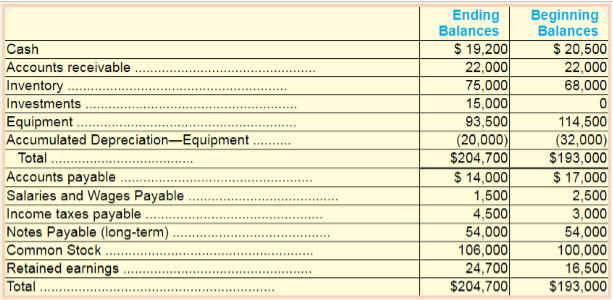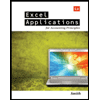
Concept explainers
(Supplement 12B) Preparing a Statement of
Golf Universe is a regional and online golf equipment retailer. The company reported the following for the current year:
• Purchased a long-term investment for cash, $15,000.
• Paid cash dividend, $12,000.
• Sold equipment for $6,000 cash (cost, $21.000;
• Issued shares of no-par stock, 500 shares at $12 cash per share.
• Net income was $20,200.
• Depreciation expense was $3,000.
Its comparative

Required:
1. Following Supplement 12B, complete a T-account worksheet to be used to prepare the statement of cash flows for the current year.
2. Based on the T-account worksheet, prepare the statement of cash flows for the current year in proper format.
(a)
Concept introduction:
Cash flow statements: It shows the inflow and outflow of cash along with the reasons, during a particular period of time. All the cash transactions are categorized in three types of activities i.e., operating, investing and financing activities.
To show:
The t-shape accounts for all the items.
Explanation of Solution
T-shape accounts for non-cash items:
| Accounts Receivable | |||
| Particulars | $ (debit) | Particulars | $ (credit) |
| Beginning Bal | 22,000 | ||
| Increase | 0 | ||
| Ending Balance | 22,000 | ||
| Inventory | |||
| Particulars | $ (debit) | Particulars | $ (credit) |
| Beginning Bal | 68,000 | ||
| Increase | 7,000 | ||
| Ending Balance | 75,000 | ||
| Investment | |||
| Particulars | $ (debit) | Particulars | $ (credit) |
| Beginning Bal | 0 | ||
| Purchased | 15,000 | ||
| Ending Balance | 15,000 | ||
| Equipment | |||
| Particulars | $ (debit) | Particulars | $ (credit) |
| Beginning Bal | 114,500 | ||
| Disposal | 21,000 | ||
| Ending Balance | 93,500 | ||
| Accumulated Depreciation | |||
| Particulars | $ (debit) | Particulars | $ (credit) |
| Beginning Bal | 32,000 | ||
| Decrease | 12,000 | ||
| Ending Balance | 20,000 | ||
| Accounts Payable | |||
| Particulars | $ (debit) | Particulars | $ (credit) |
| Beginning Bal | 17,000 | ||
| Decrease | 3,000 | ||
| Ending Balance | 14,000 | ||
| Salaries and Wages Payable | |||
| Particulars | $ (debit) | Particulars | $ (credit) |
| Beginning Bal | 2,500 | ||
| Decrease | 1,500 | ||
| Ending Balance | 1,000 | ||
| Income Tax Payable | |||
| Particulars | $ (debit) | Particulars | $ (credit) |
| Beginning Bal | 3,000 | ||
| Decrease | 1,500 | ||
| Ending Balance | 4,500 | ||
| Notes Payable (long-term) | |||
| Particulars | $ (debit) | Particulars | $ (credit) |
| Beginning Bal | 54,000 | ||
| Increase | 0 | ||
| Ending Balance | 54,000 | ||
| Common Stock | |||
| Particulars | $ (debit) | Particulars | $ (credit) |
| Beginning Bal | 100,000 | ||
| Decrease | 6,000 | ||
| Ending Balance | 106,000 | ||
| Retained Earnings | |||
| Particulars | $ (debit) | Particulars | $ (credit) |
| Beginning Bal | 16,500 | ||
| Dividend | 12,000 | Net Income | 20,200 |
| Ending Balance | 24,700 | ||
T-shape accounts for cash account:
| Particulars | $ (debit) | Particulars | $ (credit) |
| Operating Activities | |||
| Net Income | 20,200 | Inventory | 7,000 |
| Depreciation Expense | 3,000 | Accounts Payable | 3,000 |
| Income tax payable | 1,500 | Salaries and Wages Payable | 1,000 |
| Net Cash flow from operating 13,700 | |||
| Investing Activities | |||
| Sold Equipment | 6,000 | Purchased Investments | 15,000 |
| Net cash used by Investing | 9,000 | ||
| Financing | |||
| Proceed from issue of stock | 6,000 | Paid Dividends | 12,000 |
| Net Cash used by Financing Activities | 6,000 | ||
| Net decrease in cash | 1,300 | ||
| Beginning Cash | 20,500 | ||
| Ending cash | 19,200 | ||
(b)
Concept introduction:
Cash flow statements: It shows the inflow and outflow of cash along with the reasons, during a particular period of time. All the cash transactions are categorized in three types of activities i.e., operating, investing and financing activities.
To prepare:
The cash flow statement.
Explanation of Solution
| Particulars | $ |
| Operating Activities: | |
| Net Income | 20,200 |
| Depreciation | 3,000 |
| Cashflow from operating activities before working capital changes | 23,200 |
| (-) Increase in inventory | (7,000) |
| (-) Decrease in Accounts Payable | (3,000) |
| (-) Decrease in Wages and Salaries Payable | (1,000) |
| (+) Increase in Income tax payable | 1,500 |
| Cashflow from operating activities | 13,700 |
| Investing Activities: | |
| (+) Cash proceeds from sale of equipment | 6,000 |
| (-) Purchase of investments | (15,000) |
| Cashflow used in investing activities | (9,000) |
| Financing Activities: | |
| Proceeds from issue of stock | 6,000 |
| (-) Paid dividends | (12,000) |
| Cashflow used in financing activities | (6,000) |
| Net decrease in cash | (1,300) |
| Beginning Cash | 20,500) |
| Ending Cash | 19,200 |
Want to see more full solutions like this?
Chapter 12 Solutions
MANAGERIAL ACCOUNTING W/CONNECT
- I need help with this financial accounting question using the proper financial approach.arrow_forwardDuring 2022, Hunter Enterprises generated revenues of $175,000. The company's expenses were as follows: cost of goods sold of $92,000, operating expenses of $32,000, and a loss on disposal of assets of $5,000. Hunter's gross profit is_.arrow_forwardBaxter Ceramics uses the number of minutes in its heating kiln to allocate overhead costs to products. In a typical month, 7,400 kiln minutes are expected, and the average monthly overhead costs are $4,810. During March, 7,000 kiln minutes were used, and total overhead costs were $4,350. Required: Compute Baxter's predetermined overhead rate and the amount of applied overhead for March. Round your answers to the nearest cent.arrow_forward
- Can you help me solve this general accounting problem with the correct methodology?arrow_forwardA company identifies two activities: material handling and machine setup. The cost drivers are number of parts (10,000) and number of setups (200), with cost pools of $250,000 and $180,000 respectively. Product A uses 2,500 parts and 50 setups. Calculate the activity-based overhead allocated to Product A.arrow_forwardPlease explain the solution to this general accounting problem using the correct accounting principles.arrow_forward
 Intermediate Accounting: Reporting And AnalysisAccountingISBN:9781337788281Author:James M. Wahlen, Jefferson P. Jones, Donald PagachPublisher:Cengage Learning
Intermediate Accounting: Reporting And AnalysisAccountingISBN:9781337788281Author:James M. Wahlen, Jefferson P. Jones, Donald PagachPublisher:Cengage Learning Excel Applications for Accounting PrinciplesAccountingISBN:9781111581565Author:Gaylord N. SmithPublisher:Cengage Learning
Excel Applications for Accounting PrinciplesAccountingISBN:9781111581565Author:Gaylord N. SmithPublisher:Cengage Learning College Accounting, Chapters 1-27AccountingISBN:9781337794756Author:HEINTZ, James A.Publisher:Cengage Learning,
College Accounting, Chapters 1-27AccountingISBN:9781337794756Author:HEINTZ, James A.Publisher:Cengage Learning, Financial Accounting: The Impact on Decision Make...AccountingISBN:9781305654174Author:Gary A. Porter, Curtis L. NortonPublisher:Cengage Learning
Financial Accounting: The Impact on Decision Make...AccountingISBN:9781305654174Author:Gary A. Porter, Curtis L. NortonPublisher:Cengage Learning Cornerstones of Financial AccountingAccountingISBN:9781337690881Author:Jay Rich, Jeff JonesPublisher:Cengage LearningPrinciples of Accounting Volume 1AccountingISBN:9781947172685Author:OpenStaxPublisher:OpenStax College
Cornerstones of Financial AccountingAccountingISBN:9781337690881Author:Jay Rich, Jeff JonesPublisher:Cengage LearningPrinciples of Accounting Volume 1AccountingISBN:9781947172685Author:OpenStaxPublisher:OpenStax College





